An evening of high-spirited dance showcases new works by local artists
By Giselle Au-Nhien Nguyen, Cameron Woodhead and Andrew Fuhrmann
DANCE
(Un)tethered ★★★
Space 28, Southbank, until November 9
The annual public performance by graduating dance students at the VCA is always a fascinating event because it offers a chance to see established local and sometimes international artists experimenting with larger scale choreographies.
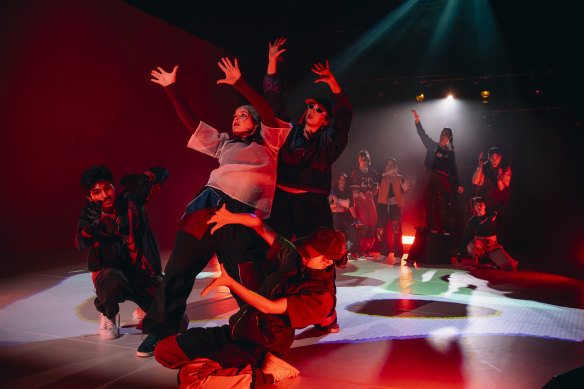
(Un)tethered, by the graduating year of dancers at the Victorian College of the Arts.Credit: Gregory Lorenzutti
This year’s lively showcase features new work by four Melbourne-based choreographers, including two VCA alumni, and runs the gamut from street dance to high-concept live art.
In the first piece, David Prakash works with a large ensemble using breakdance, freestyle and krumping in a colourful exploration of different forms of socialising, enjoying dance and exchanging energy.
Collected in a circle, the performers and the audience mingle to create a heightened sense of community while in the middle the dancers throw down their moves. It’s not a competition but rather a free form parade of youthful exuberance.
Next, Chimene Steele-Prior presents an elegant but wonderfully atmospheric piece highlighted by intricate patterns and sophisticated transitions. This piece, more than the others, respects and works with the strengths of the graduating dancers.
After the interval, Sarah Aiken uses props and dynamic projections in a loose but playful study of space and gesture. The layered visuals frame, obscure and augment the presence of the dancers, filling the stage with flickering movement.
The final piece, by Luke George, opens with the image of three dancers bound in ropes and held in classical attitudes. It’s a tableau recalling the way that painters used belts, straps and harnesses to help models hold their poses.
In a different context, this striking image – sustained over a longer duration – might have been enough. George, however, lets the ensemble work themselves into a great tangle, playing with different arrangements of weight and tension.
And so an evening of high-spirited dance ends in a colourful web of connections and shifting alliances, where every movement speaks to the delicate balance between constraint and freedom, pressure and release.
Reviewed by Andrew Fuhrmann
THEATRE
Rhinoceros ★★★★
Adapted by Zinnie Harris from Eugene Ionesco
Spinning Plates Theatre Co, 45 downstairs
Until November 17
Theatregoers should hotly anticipate a new outing from Spinning Plates Theatre Co, after their stylish and toothsome production of The Crocodile last year. That one was based on a Dostoevsky short story about a bureaucrat who gets swallowed whole by a croc and thrives inside it. The second in their planned “Beast Trilogy” turns to Ionesco’s Rhinoceros, a classic from the Theatre of the Absurd.
The play has a storied history in Melbourne. At the last indie production I saw, the ceiling caved in minutes from the end, as the cast tried to satisfy one of Ionesco’s ridiculous stage directions (in that case, a rhinoceros stampede) by jumping up and down on the second floor of a decrepit Edwardian terrace.
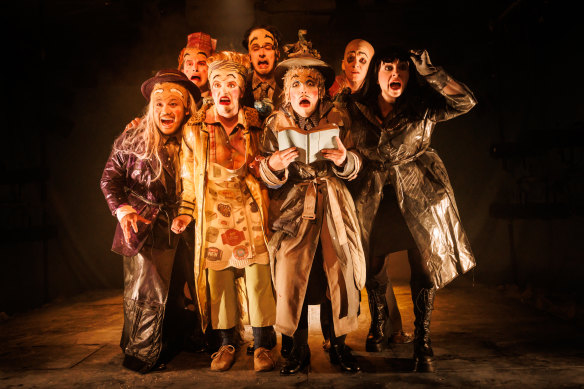
One of this show’s pleasures lies in the inventiveness of the theatrical world it creates.Credit: Darren Gill
A triumph of design avoids repeating that fate, and one of this show’s pleasures lies in the inventiveness of the theatrical world it creates. Rhinoceros is, after all, about a town where everyone – except the scruffy, hard-drinking antihero Berenger (Cait Spiker) – turns into a rhinoceros. How the artists are going to make the insanity of that work is its main mystery.
Five stars to Dann Barber’s costume, inspired by a miscellany of French fashions, artistic movements and kitsch. It’s full of glorious visual comedy and surreal surprises, as if Magritte were dreaming of the Ancièn Regime in some op shop in the sky. And it becomes a crucial part of the absurdist action, too.
You’ll never forget the scene in which Berenger’s perfectionist mate Jean (James Cerché) transmogrifies into a rhino onstage. Or a housewife (Belinda Andrson-Hunt) indulging performative trauma over a (disgusting) dead cat. Or the crocheted lust of Mrs. Boeuf (Annabelle Tudor) before she finds insta-love with her newly rhinocified husband. Or the comically dehumanising dimensions of Berenger’s boss (Alexandra Aldrich) as he barks pointless orders in a workplace while the world runs amok.
Sound design handles the megafaunal incursions with mysterious urgency. Unforgiving lighting leaves the performers nowhere to hide, save trapdoors littered over the bare black square of stage, out of which characters pop and slither back into like some whack-a-mole machine on the blink, lending a bizarre sense of carnival to proceedings.
The performance style emphasises grotesque and heightened caricature, much of it inspired by bouffon clowning – with a few screeching sallies into Artaud’s Theatre of Cruelty – and if there are occasional blips in the timing and co-ordination of the ensemble, it works well in contrast to Spiker’s lackadaisical Berenger.
Berenger in Rhinoceros is a totally different creature from Berenger in Ionesco’s Exit the King (a play Australian audiences might remember from Geoffrey Rush’s performance in 2009, which went on to win a Tony Award on Broadway).
Here, Spiker encapsulates and embodies a paradox – impressively, by delivering a portrait of an antihero so unimpressive, so wanting in obvious merit of any kind… except that they’re so much themselves (and so half-arsed about taking themselves seriously) that they can resist the siren call of the madding crowd.
There’ll be people who want this production to be more “relevant”, who’d prefer to be bashed over the head with all Rhinoceros has to say to contemporary political extremism and conspiratorial thinking and the lure of tribalism run rampant and the urgent risks all those things pose to social cohesion.
I say they do not like thinking for themselves. The faithfulness of Cassandra Fumi’s production to the mysteries and traditions of absurdist theatre will get up the noses of anyone who wants to ignore their capacity to turn rhinoceros – and is stronger for it.
Reviewed by Cameron Woodhead
MUSIC
Coldplay | Music of the Spheres World Tour ★★★
Marvel Stadium, until November 3
More than anything else, a Coldplay concert is a spectacle. It has all the hallmarks of a big-bucks production: confetti, fireworks, streamers, flames, large balls bouncing across the crowd, light-up wristbands that pulse in sync to create a visual symphony.
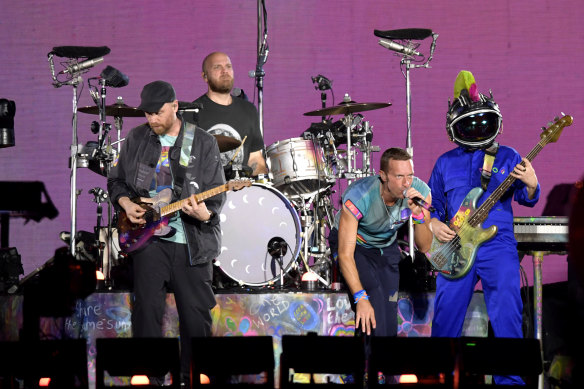
Coldplay scrambled to find a replacement bassist before their show. Producer Bill Rahko (right) stepped up.Credit: Martin Philbey
The music almost feels secondary to the extravagance on display, but even that is a long way from the British band’s stripped-back beginnings over 20 years ago – their more recent tunes have all the inspirational gravitas of a bumper sticker, but it’s all delivered with confidence by leader Chris Martin.
This tour exclusively came to Perth last year, so it’s been a long time between drinks for east coast fans, who last saw Coldplay in 2016.
In a career-first, the band is playing without its full line-up – Martin comes on stage before the show kicks off to explain that bassist Guy Berryman is unwell and “vomiting”, and that a “strange, alien, weird friend character” would be taking his place. The band’s co-producer and engineer Bill Rahko steps up to the plate, wearing a helmet for the whole show – and for a last-minute gig, he does remarkably well.
Martin is a charming frontman with a dash of chaotic energy: he cracks jokes, tells zany anecdotes and has a huge grin on his face the entire night.
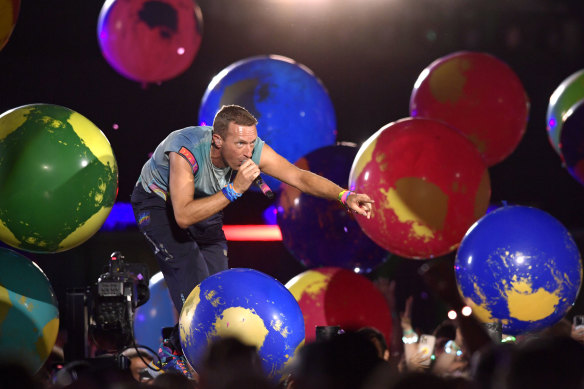
Chris Martin is a charming frontman with a dash of chaotic energy.Credit: Martin Philbey
There are splashes of Australian culture throughout the show, from a few bars of You’re the Voice and Locomotion, to a tribute to Shane Warne with an acoustic performance of Sparks. It’s these lower-key moments that have more impact, allowing the music to stand on its own – when Martin takes to the piano for The Scientist and nails the falsetto in Fix You, you can hear a pin drop.
Counter that with the presence of the Weirdos, the Muppet-style characters that have been a part of the band’s act since 2021. They’re contentious even among Coldplay’s biggest fans, but for a casual concertgoer, they’re downright confounding. Appearing via the big screen, they even sing a song – Human Heart – and their leader, a female Weirdo named Angel Moon, instructs the crowd to don “Moon Goggles” towards the end of the night to enter a new world of colour. The goggles – disposable 3D glasses distributed at the point of entry – insert love hearts into the landscape.
There’s no doubt this is a great night out and a pop show for the ages – but all the platitudes about love and peace and joy and harmony feel generic. When the music speaks for itself, it’s far more powerful.
Reviewed by Giselle Au-Nhien Nguyen
JAZZ
ELIO VILLAFRANCA ★★★★
The Jazzlab, Saturday 2 November 2024
Elio Villafranca may be a musician by profession, but he’s also a masterful storyteller. The Cuban-born, New York-based pianist writes music that delves into his cultural heritage, his passions and his lived experience – all of which are brought into sharp focus on his latest album, Standing by the Crossroads.
It’s Villafranca’s most personal album to date, filled with musical evocations of significant people, places and moments in the composer’s journey so far. At Jazzlab, he introduced us to the new repertoire and offered fascinating insights to further enrich these sonic portraits.
With warmth and candour, he shared memories (both joyful and painful) of his childhood in Cuba, his move to America, his burgeoning love of jazz and his rediscovery of ancient Afro-Cuban traditions. Those memories were brought to life in musical form by Villafranca and a sextet of superb Australian musicians, brought together by Sydney saxophonist Gai Bryant.
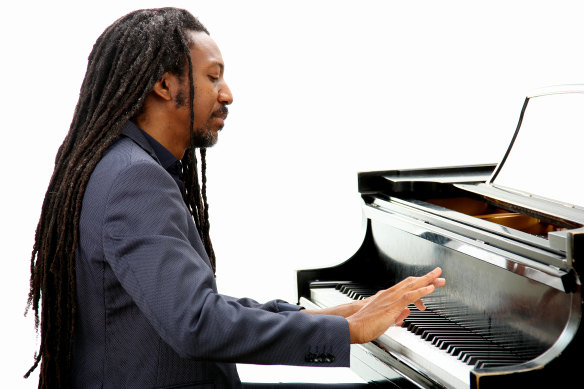
Elio Villafranca’s latest album is his most personal yet.Credit: Jerry Lacay
Bryant – whose own music often combines Latin rhythms with contemporary jazz – has toured and performed with Villafranca on numerous occasions, and helped shape the composer’s intricate arrangements as they unfolded. At one point, she pointed to the elaborate sheet music in front of her and described it (only half-jokingly) as “frightening” in its complexity, before the band launched into a thrilling evocation of an agitated beehive, all buzzing horns and jostling rhythms.
Many of the tunes were pinned to unconventional Afro-Cuban claves (rhythmic patterns) that stretched across multiple bars, creating interlocking time-feels over which the band layered shifting melodies and harmonies. Yet despite the complexity, the music always maintained a sense of flow, propulsion and groove.
And not every tune was laden with polyrhythmic puzzles. Villafranca’s fleet runs and plunging chords could dissolve into hushed melancholy or gleaming beauty, as they did on Solitaria and San Isidro, Part 1.
On the final number (No Man’s Land), Villafranca traded his piano for a cowbell in an animated three-way conversation with drums and percussion, before coaxing the full ensemble to a rousing, dramatic finale.
Reviewed by Jessica Nicholas
THEATRE
Your Name Means Dream ★★★★
Red Stitch, until Nov 24
Who isn’t worried about losing your job to advances in robotics and the pursuit of AI? Of all careers, you’d think actors would be future-proof from the rise of the replicants, although I’ve been a critic long enough to have seen a lifelike android from Japan onstage. It was beautiful and creepy, diving deep into the so-called “uncanny valley” between human life and an obvious simulacrum of it, it yet posed no threat to a skilled performer. If Lucy Ansell’s astonishing performance as a robot carer in José Rivera’s Your Name Means Dream is anything to go by, it is androids who should be paranoid.
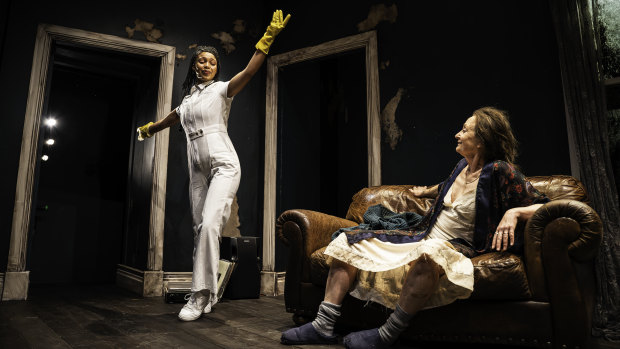
Lucy Anstell (left) is astonishing as the robot carer to Caroline Lee’s Aislin.Credit: James Reiser
This sci-fi two-hander takes us into a claustrophobic apartment in a dystopian future New York. Aislin (Caroline Lee) is an ageing, potty-mouthed addict, a grieving and embittered woman who has shut herself off from the world. Her rich son cannot – or does not want to – have her in his life, so he pulls strings to purchase Stacy (Ansell), a prototype care-bot from the ominously named megacorporation, Singularity, to keep her company and meet her every need.
Hilarious conflict ensues as a pissed-off Aislin hurls torrents of invective at Stacy and marshals every argument under the sun against the arrangement. She will not be making friends with a toaster, and nothing Stacy could ever do can substitute for the love and care and human companionship her no-good son should provide. Or can it? Ansell’s almost trans-human talent genuinely makes you wonder.
It’s a fascinating acting challenge. Stacy’s a lopsided creature. She far outstrips human capacities that can be reproduced through raw data. She knows every joke ever told, every song ever sung. She can perfectly imitate rock legends or recite Walt Whitman’s entire corpus or teach Aislin to waltz. And yet she relies for her personality and effectiveness on machine learning from Lee’s spiky and self-destructive curmudgeon.
The intricate emotional (and deeply philosophical) dance that develops between them is a histrionic feat no technology could ever replicate. It’s arresting theatre. All kinds of human ugliness underscore the fragile beauty.
There are echoes of slavery in Rivera’s world-building, and gangs of humans roaming the streets murdering androids. There’s the controversial “approximation of soul” software denounced by the Pope, or Stacy’s body memories of her previous incarnation as a sex bot.
Given the brilliance of the first two-thirds of this play, it’s a shame Rivera’s ending has such a gloss of predictable sentiment. Not saying a machine could have written it, but it doesn’t feel entirely organic or dramatically satisfying. Still, this production, guided by the sure intuitions of director Kat Henry, sports rich and profoundly imagined performances as good as you’ll see anywhere in the world. Only human artists at the top of their game can make theatre as electric as this.
Reviewed by Cameron Woodhead
The Booklist is a weekly newsletter for book lovers from Jason Steger. Get it every Friday.